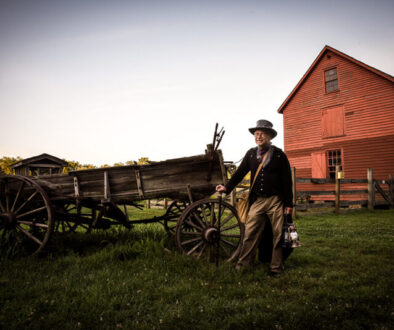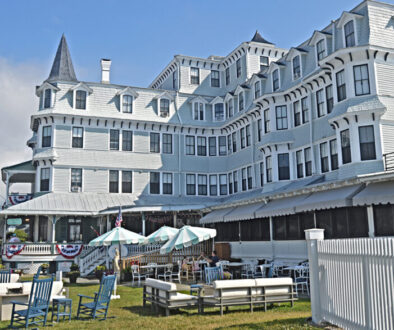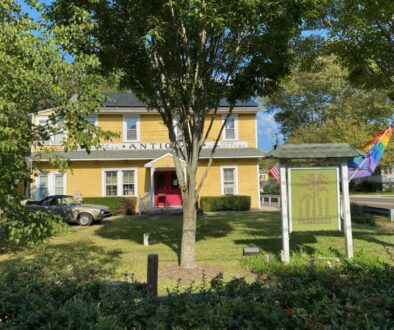Southern Mansion: A Wedding Belle

It is 20 years since the newly-restored Southern Mansion hosted its first wedding celebration. Since then, more than 500 brides and grooms have said their “I dos” at the Cape May villa built during the Civil War by wealthy Philadelphia industrialist George Allen.
The classic Italianate elements—the high wraparound porches, cupola, spacious interior reception rooms with tall windows, intricately detailed moldings, multiple marble fireplaces and massive gold-leafed mirrors provide an appealing setting for weddings, large or intimate. Situated on an acre and a half of beautiful gardens, recessed from 720 Washington Street in the heart of Cape May’s historic district, the property offers privacy and the ethos of an earlier era. The fact that the structure has maintained its grandeur for more than 150 years is testament to the skill of design and construction, the durability of building materials, and its careful, costly restoration.
For George Allen, the seaside estate was a statement of his success and riches. Owner of department stores in Center City Philadelphia and Germantown, he dealt in cloth and clothing, and operated mills where the materials were made. During the war, his fortunes multiplied as he sold items to the North and South, including caps for both Union and Confederate soldiers. He used his opulent new mansion not only for entertaining family and friends, but also business guests. Cape May was popular with southern planters prior to the war. The resort was accessible by steam ship, transporting southern families and servants—and even their horses and carriages—to the cooling ocean and bay breezes.


The Allen House was designed by nationally famous Philadelphia architect Samuel Sloan [1815–1884]. Sloan specialized in mansions for rich plantation owners in the South prior to the war. His most famous, the ornate octagonal Longwood, at Natchez, Mississippi, was never finished. Sloan was forced to flee and return to Philadelphia in 1861 when the war descended on Natchez. He then became available for Allen’s Cape May project, which was constructed in 1863-64. Sloan was author of pattern books showing detailed sketches of prospective mansions. Drawings of a “Southern Mansion” in one of the books obviously were used in the design of Allen’s house.
Since its origin, weddings have punctuated important chapters of the history of this architectural gem.
George Allen had no children of his own, but his niece Esther, daughter of his sister, also named Esther, was married at the estate in a large and fancy Victorian wedding. In fact, the mansion was enlarged for the festivities. A glassed solarium was added, and to this day, remains an important aesthetic for the many contemporary weddings held at the property.
Mementoes of George Allen’s niece’s wedding were discovered many years after the bride, Esther Dougherty, exchanged vows with Frederick Stovell on October 4, 1905.
When Barbara Bray Wilde bought the property in 1994, it was a rooming house that had fallen into serious disrepair. The grand symmetry had been split into 20 rooms, each with a gas refrigerator and stove. Debris filled the basement and attic. As Barbara and crew cleared away junk, she came upon evidence of the wedding. Framed and in good condition were large photographs of Esther’s nuptials—family pictures of the wedding party and an image of guests seated at a meal on a long table spread with white cloth, flowers, and delicate china.
Barbara believes Esther “wanted to be rediscovered.” There are ghost hunters and ghost writers who have frequented the mansion in recent years, and claim that Esther’s spirit is, indeed, alive and palpable.


They report hearing her laughter and footsteps, smelling her perfume, and sensing the rustle of her skirts. I don’t believe in ghosts necessarily, but after visiting the mansion recently, I have been obsessed with finding out more about Esther. If her wish was to be rediscovered, I found some fascinating details.
The Philadelphia Inquirer reported on October 8th, 1905: “Though Miss Esther Dougherty and Mr. Frederick Devant Stovell were wed at the bride’s summer home at Cape May, Philadelphia society was well represented. Mr. John A. Green took a large party of guests to Cape May in his private rail car to attend the wedding of his nephew. Miss Dougherty is the older of Mr. Charles Dougherty’s two daughters, and is a charming, talented young lady. The wedding decorations were decidedly seasonal—golden rod, autumn leaves with their rich colors, and pink and white dahlias.”
Though small in stature, a shrinking Victorian violet Esther was not. Almost weekly during summer seasons starting in 1888, she was mentioned in The Philadelphia Inquirer sporting news for winning competitive women’s golf at Cape May. Golf was a relatively new sport, especially for women, and she excelled.
Billie Biddle in his “Chats of Social Doings” in the Inquirer, September 15, 1901, wrote: “Miss Esther Dougherty, the daughter of Colonel Charles D. Dougherty, whose palatial residence on Washington Street is one of the show places at Cape May, is undoubtedly the foremost athletic girl at Cape May. In the recent rifle shooting contests at the Gun Club, she has so far distanced her fair competitors to be in a class by herself. [A cartoon with a woman in Victorian sports dress and a rifle accompanied the article.] As a golfer, she has won many prizes in tournaments in which some of the best women players in this part of the country have taken part. The other day, I noted her captaining a baseball nine, largely composed of society men and playing a game at short stop that would have done credit to the average amateur player. Miss Dougherty is a tremendous favorite at the shore and is in great demand at dances.”
Two years after her marriage, Esther Dougherty Stovell was in the newspaper headlines again—this time for taking her father to court demanding an accounting of her late mother’s $200,000 estate [worth more than five million in 2019 dollars]. She accused her father, who was in command of her grandfather Allen’s Cape May property, of “needless spending.”


The May 26, 1922 Philadelphia Inquirer reported that Esther Stovell was suing her husband for divorce, charging desertion. According to the article: “The formal announcement of the suit did not come as a surprise to close friends of the couple who are widely known in society circles in Philadelphia, Baltimore and New York. It had been known for some time they were living apart. ‘The charge is simple desertion,’ said Mrs. Stovell last night. ‘There is nothing more about the case. Mr. Stovell is in Maryland.’ Mrs. Stovell was formerly Miss Esther Dougherty. The marriage was celebrated in Cape May in 1905. There are no children.”
In March the following year, The Philadelphia Inquirer headlined the next chapter, reporting:
“Frederick D. Stovell Married in Maryland, Divorced Clubman Takes Bride Month After First Wife Rewed.
Word of the marriage of Frederick D. Stovell, formerly of the city was received here yesterday from Maryland. Mr. Stovell was divorced last December by his first wife, Mrs. Esther D. Stovell who charged desertion—asserting he was living in Maryland.
A month ago Mrs. Stovell was married to Ulysses Mercur, well-known clubman, in her home at 2225 Delancey Place where the couple is living.
Mercur, who is a graduate of Princeton, is a member of the Rittenhouse Club, the Huntingdon Valley, Philadelphia, Merion Cricket, University, Germantown Cricket, and other clubs. Mercur, a Princeton baseball player, was credited to be among the first college players to throw a curve ball.”

During both marriages, Esther entertained in elaborate style at the house her grandfather built. The parties became legendary, especially in the 1920s, when Ulysses Mercur joined his wife as host. They danced the Charleston in the ballroom, importing socialites from nearby cities and inviting locals with pedigrees. During prohibition, current owner Barbara Wilde says, “They picked up illegal alcohol at Cape May Point where boats made drop offs on beaches.” One of Barbara’s favorite pieces of memorabilia, found in the attic, is a Western Union telegram—a thank you note to Esther and Ulysses Mercur. It reads:
Dear Uly,
My trousers were missing this morning
My trousers are down by the sea
So Esther and Uly, my loved ones
Please post my panties back to me
Ulysses Mercur is said to have relinquished the property hurriedly after Esther’s death. He could not bear to be there without her. He sold the three-story mansion and all the fine furnishings for $8,000 in 1946—less than the cost to build it almost a century earlier.
Wedding sentiments are also attributed to the next owners of the Allen estate. Daniel Crilly is said to have purchased the property as a belated wedding gift for his wife Mary. Soon the size of the house and expanse of the grounds became financially and physically overwhelming for the couple. To make ends meet, they licensed the mansion as a rooming house. At the time, the bloom had faded from Cape May as a popular resort. The country was recovering from World War II, and the Depression had wiped out fortunes of the privileged who had spent entire summers at the shore.
Tragedy struck the Crilly family in the 1960s. The daughter died at a young age followed by the deaths of Mr. Crilly and his son, leaving Mary Crilly alone to manage the rental units, then called Victorian House. She did so for 30 years, until her 90s. Former tenants have said she was strict about noise, lights, and turning in early. She did not want to irritate neighbors and the police and have her license revoked, though it was terminated in the 1980s when the property was deemed unsafe for tenants.
Current owner Barbara and her then-boyfriend saw a “For Sale” sign on the property when they were vacationing in 1994. “We sneaked in,” says Barbara, “and found the ceilings falling in, the roof falling in, the floor falling in.” Despite the damage, the once-grand rooms cut into cubicles, and debris everywhere—Barbara Bray and Rick Wilde visualized a future, and weddings were an important factor. “When you take on the restoration of a historically significant property,” says Barbara, “you need to have an income-producing market for its use. You have to bring in paying guests. People have no idea the cost of maintenance of a property like Southern Mansion. We are always redoing—the slate, the woodwork, the painting, the plumbing, the landscape, updating the ambiance.”
Barbara Bray and Rick Wilde purchased the property within three days of their clandestine tour and set about a complete restoration, “20 hours a day for 18 months,” restoring the derelict rooming house to its former elegance as a luxury bed and breakfast, a trend that had been established among historic homes in Cape May. (Barbara and Rick did take time from their restoration work to be married on the grounds. They have since divorced.)
The restoration was daunting. Barbara says main beams were rotting with age. New I-beams were installed to support the three-story structure with wraparound porches. Electricity and plumbing were replaced, including new heating, air conditioning, and sprinkler systems to meet current codes. The slate and tin roofs were replaced. New porches, moldings and brackets were installed. Damaged interior moldings, a hallmark of the house, were reproduced on site. To speed and assure quality of carpentry, a mill workshop was created in the basement. Thirty-inch granite basement walls were waterproofed. All exterior wood was ground down from years of white paint and repainted in the original earth tones. All five chimneys were rebuilt using the original bricks. And finally, the finial atop the cupola was re-gilded.
Amid the debris, Barbara found a lithograph of Samuel Sloan’s design for a “Southern Mansion,” realizing it was, indeed, the prototype for the property including a sketch of a wing that had not been included in the original structure. With a leap of faith, a massive investment, and the goal of a very special wedding venue, the Bray-Wilde team contracted architects and builders and sought approvals to construct the wing Sloan had envisioned in his drawings. The new South Wing was completed in 1997. Its 12,000 square feet includes 10 additional guest suites, 12 bathrooms, a second ballroom, a commercial kitchen, three balconies, a gallery, veranda, solarium, and two high circular staircases, all designed and built in the same style and decor as the original mansion.



The Southern Mansion accommodations allow for everything from a single bed-and-breakfast guest to a wedding for 150. There are weddings using the entire property with all 24 rooms reserved for the celebration including a weekend of meals, music, dancing in ballrooms, cocktails in solariums and festivities on the lawn. The most elaborate wedding entertained 170 guests for a long weekend, including the special delivery of dozens of pieces of wicker furniture for them to lounge about the garden.
Barbara Bray Wilde, looking back at 20 years of weddings, says that Cape May’s distinction as one of the nation’s leading destinations for nuptials is a key to the island’s economy. “There are weddings in early spring, summer, especially in fall, and now winter. Weddings bring in guests who have never visited before. They are charmed and return as vacationers. We have couples married at the Southern Mansion who come back for anniversaries, birthdays, and special holidays. They bring their children and extended families. The economics of weddings at our town’s historic structures are a major factor in maintaining our architectural heritage.”
The first wedding of this season happened the weekend of April 13, with 90 guests amid the blooming daffodils, jonquils, crocus and hyacinths. Manager Denise Najera says the Southern Mansion wedding bookings for 2019 are filling fast, especially for the fall. September and October are the most popular months. It was in October, 114 years ago, that Esther, the belle of this spectacular house, left indelible evidence that she would be remembered.
In an original pane of glass in a second-floor bedroom, Esther inscribed her maiden name Dougherty, etching the glass with her engagement ring, a tradition of society girls at the time, and a lasting, visible reminder of her presence.



